It was the 1956 rerelease of Fantasia that rocked my world. I was four years old and Mom took me to a Buffalo, NY theater to see my first movie. The images and the music made a lasting impression, driving a lifelong love for symphonic music.
I already was in love with illustrative art, thanks to the Little Golden Books that my mother brought home from her weekly grocery shopping trips. My favorite was I Can Fly, illustrated by Mary Blair. And on my wall were Vacu-Form Nursery Rhyme characters including Little Bo Peep, Little Boy Blue--which I later discovered were also designed by Mary Blair! And even later in life, I learned that Mary Blair had worked for Walt Disney. And of course, growing up in the 1950s, anything Disney was a favorite.
Especially the 1959 release of Sleeping Beauty. I was still in my 'princess' phase, which came after my 'cowboy gunslinger' phase. Mom took me to see the film. I had the Disney Sleeping Beauty coloring book. I had the Little Golden Book. And I had the Madame Alexander Sleeping Beauty doll! Sadly, my dog chewed it up but in my 40s I purchased one on eBay to satisfy my inner child.
Fast forward to the late 1980s and my husband and I were buying up Disney videotapes for our son, raising another generation of Disney fandom. His first theatrical movie was The Little Mermaid.
My fandom never took me as far as to read books about the Disney franchise or Walt. Until The Queens of Animation: The Untold Story of the Women Who Transformed the World of Disney and Made Cinematic History. I remembered my love of Mary Blair and thought, Nathalia Holt has something here. I wanted to know the names and the contributions of these unknown women.
It was a joyful read, at once a nostalgic trip into the films that charmed and inspired my childhood-- and our son's --and a revealing and entertaining read about the development of animation and the rise of women in a male-dominated culture. I put aside all other books.
Holt concentrates on the women's careers but includes enough biographical information to make them real and sympathetic. I was so moved to read about Mary Blair's abusive marriage.
Holt also does a stellar job of explaining the rising technologies that would impact animation, eventually eliminating the jobs of hundreds of artists. We learn about Walt's interest in each story that inspired the animated movies and the hard work to develop the story, art, and music, along with the conflicts and competition behind the scenes.
I learned so many interesting facts! Like how Felix Salten's novel Bambi: A Life in the Woods was banned in Nazi Germany because it was a metaphor for Anti-Semitism! How Mary Louise Weiser originated the grease pencil, one of the many technologies Disney developed and perfected or quickly adapted.
And I loved the story of Fantasia. Bianca Majolie presented the music selections to Walt, including The Nutcracker Suite's Dance of the Sugar Plum Fairy and the Waltz of the Flowers. Tchaikovsky's The Nutcracker ballet had never yet been produced in the United States at the time! The male animators did not want to work on illustrating fairies (they instead created the Pastoral Symphony's centaurs and oversexualized centaurettes, including an African-American servant who was part mule instead of horse).
Choreographer George Balanchine was touring the studio with Igor Stravinsky, whose The Rite of Spring was included in Fantasia, and he loved the faires in the Dance of the Sugar Plum Fairies. Fifteen years later he debuted The Nutcracker at the new Lincoln Center and it became a Christmastime annual tradition.
I just loved this book for so many reasons! Thank you, Nathalia Holt!
I was given access to a free egalley by the publisher through NetGalley. My review is fair and unbiased.
The Queens of Animation: The Untold Story of the Women Who Transformed the World of Disney and Made Cinematic History
by Nathalia Holt
Little, Brown and Company
Pub Date 22 Oct 2019
ISBN 9780316439152
PRICE $29.00 (USD)
Thursday, November 14, 2019
Wednesday, November 13, 2019
News, Quilts, TBR
This week it became real that winter is coming. We had our first snowfall here in Metro Detroit. We planted bulbs on Monday, the leaves on our trees started to fall on Tuesday, and it snowed on Wednesday. By the weekend we were breaking records for coldest days.
It's all happening too fast!
 |
| photo by Tom Gochenour, my brother |
We have been so busy lately choosing new livingroom and entryway flooring, driving to showrooms and calling for quotes. I finally fit in a class for my 'new' sewing machine which is now ten months old. I restarted working with the fitness coach after my surgery, but I'll have to start easy as I still can't lift over ten pounds or do any lower body workouts.
But I made sure to attend a talk by April Anue, Fiber Artist and owner of Your Heritage Quilts LLC, about her quilt Strange Fruit at the St. John's Episcopal Church in Royal Oak, MI.
April told the audience how God called her to find the names of the 5,000 victims of lynching between 1865 and 1965 and to undertake the sacred duty to record them in this quilt. Every stitch was blessed by her tears.The quilt appears in the book Quilts and Human Rights published by Michigan State University Press. See an interview at https://www.youtube.com/watch?v=idammoba2Po
When my family moved to Royal Oak in 1963 my grandfather would pick me up and take me to church here. I was confirmed here, knelt at this altar rail for communion. It was a profound experience to encounter both God and American sin in this space.
April brought another quilt made in memory of the child Syrian refugee found dead on the shores of Turkey, Alan Kurdi.
April said she doesn't make 'pretty quilts.' As you can see from the quilt above, the workmanship and colors and fabrics and design are gorgeous, but the message is disturbing. Art makes us see things anew.
But my latest quilt is 'pretty', meant to use some of my drawers of scrap fabrics. I created Hexie flowers and appliqued them. I call it April Showers Bring May Flowers.
It was machine quilted by Maggie Smith.
During my recovery from surgery, I embroidered five more original designs for my Wizard of Oz quilt which has been languishing for five years.
Our library held their semiannual book sale and I found some great books.
My NetGalley TBR shelf includes some real impressive reads:
- Lady Clementine by Marie Benedict
- American Dirt by Jeanine Cummins
- Things in Jars by Jess Kid
- A Good Neighborhood by Therese Anne Fowler
- Eden Mine by S. M. Hulse
- The Great Unknown by Peg Klingman
- Miss Austen by Gil Hornby
- Exploring Your Creative Voice in Contemporary Quilt Art by Sandra Sider
- The Jane Austen Society by Natalie Jenner
- Frida in America by Celia Stahr
- These Fevered Days by Martha Ackmann
I still have book win Polite Society by Mahesh Rao to read and will be receiving Father of Lions by Louise Callaghan from Bookish.
I am reading The Overstory by Richard Powers with the Facebook Now Read This group sponsored by PBS Newshour and the New York Times Book Review. It is powerful. Readers have been sharing photographs of trees in their lives. My contribution was my childhood home's Weeping Willow Tree.
And this weekend we puppysat just Ellie.
Tuesday, November 12, 2019
There's Something About Darcy: The History of a Romantic Archetype
I became a Janite in 1978.
At Temple University a professor told our class there were three courses we should not miss and I took them all. Toby Olshin's honors class on Jane Austen was one; it had a huge impact on me as a student and a reader.
In 1978 no one could foresee Jane Austen becoming universally recognized or Darcy taking precedence as our favorite literary romantic hero. Although Pride and Prejudice was early adapted for the stage, it took film to reach a wide audience. Darcy's various film portrayal have eclipsed Austen's original in the public mind. Darcy has become Colin Firth in a wet shirt or Mathew Mcfayden's soulful sensitivity.
 |
| Darcy hands Elizabeth a letter. Regency Redwork, a Pride and Prejudice Storybook quilt by Nancy A. Bekofske |
I was engaged while reading about literary heroes before and after Darcy, including Rochester and Heathcliff.
I had seen many of the various film adaptations she discusses but was getting overwhelmed by the time she came to contemporary novels and spin-offs. I was overloaded. I have not read many of these books, and although she explains each book's plot and such, I was often reduced to skimming the text.
Malcolm has given me a lot to think about and I feel impelled to revisit the novel and the famous film versions with her interpretation in mind.
I was granted access to a free egalley by the publisher through NetGalley. My review is fair and unbiased.
There's Something About Darcy
by Gabrielle Malcolm
Endeavour Quill
Pub Date 11 Nov 2019
ISBN: 9781911445562
PRICE: £9.99 (GBP)
from the publisher:
For some, Colin Firth emerging from a lake in that clinging wet shirt is one of the most iconic moments in television. But what is it about the two-hundred-year-old hero that we so ardently admire and love?
Dr Gabrielle Malcolm examines Jane Austen’s influences in creating Darcy’s potent mix of brooding Gothic hero, aristocratic elitist and romantic Regency man of action. She investigates how he paved the way for later characters like Heathcliff, Rochester and even Dracula, and what his impact has been on popular culture over the past two centuries. For twenty-first century readers the world over have their idea of the ‘perfect’ Darcy in mind when they read the novel and will defend their choice passionately.
In this insightful and entertaining study, every variety of Darcy jostles for attention: vampire Darcy, digital Darcy, Mormon Darcy and gay Darcy. Who does it best and how did a clergyman’s daughter from Hampshire create such an enduring character?
*****
Learn more about Jane Austen:The Jane Austen Center, where I first heard about There's Something About Darcy
https://www.janeausten.co.uk/exhibition/
The Making of Jane Austen by Devoney Looser
https://theliteratequilter.blogspot.com/2017/06/the-making-of-jane-austen-creation-of.html
Jane Austen at Home by Lucy Worsley
https://theliteratequilter.blogspot.com/2017/07/jane-austen-at-home-by-lucy-worsley.html
Jane Austen: The Secret Radical by Helena Kelly
https://theliteratequilter.blogspot.com/2018/02/austen-finishes.html
Simply Austen by Joan Klingel Ray
https://theliteratequilter.blogspot.com/2018/08/simply-austen-concise-and-comprehensive.html
Jane Austen for Kids by Nancy I. Sanders
https://theliteratequilter.blogspot.com/2019/02/jane-austen-for-kids.html
Austen for Kids: Persuasion and Sense and Sensibility
https://theliteratequilter.blogspot.com/2019/05/jane-austen-classics-from-baker-street.html
Jane Austen's Inspiration by Judith Stove
https://theliteratequilter.blogspot.com/2019/08/jane-austens-inspiration-beloved-friend.html
Jane Austen Derivatives and Fan-Fiction:
Mary B by Katherine Chen
https://theliteratequilter.blogspot.com/2018/07/mary-b-plain-bennett-sisters-story.html
Eligible by Curtis Sittenfeld
https://theliteratequilter.blogspot.com/2018/04/curtis-sittenfeld-eligible-and-you.html
Northanger Abbey by Val McDermid
https://theliteratequilter.blogspot.com/2019/06/northanger-abbey-by-val-mcdermit.html
Unmarriageable by Soniah Kamal
https://theliteratequilter.blogspot.com/2019/03/unmarriageable-pride-and-prejudice-in.html
By the Book by Julia Sonneborn
https://theliteratequilter.blogspot.com/2019/08/mini-reviews-by-book-and-man-who.html
The Bridgit Jones series by Helen Fielding, including
Bridgit Jones's Baby
https://theliteratequilter.blogspot.com/2017/04/mini-reviews-family-problems.html
Not yet reviewed is Polite Society by Mahesh Rao
 |
| Polite Society with my Austen Family Album quilt |
Northanger Abbey
https://theliteratequilter.blogspot.com/2018/05/northanger-abbey.html
Persuasion
https://theliteratequilter.blogspot.com/2015/05/anne-eliot-vs-modern-perky-heroine.html
Jane Austen Quilts:
Pride and Prejudice Storybook Quilt
https://theliteratequilter.blogspot.com/2012/02/pride-and-prejudice-story-book-quilt.html
Regency Redwork: a Pride and Prejudice Storybook Quilt
https://theliteratequilter.blogspot.com/2016/11/my-regency-redwork-pattern-is-featured.html
Austen Family Album
https://theliteratequilter.blogspot.com/2018/02/austen-finishes.html
Jane Austen's Quilt Reproduction Pattern from Linda Franz
https://lindafranz.com/shop/jane-austen/2
Jane Austen Quilts Inspired By Her Novels by Karen Gloeggler
https://shop.americanquilter.com/books/ebooks/1427-ebook-jane-austen-s-quilts-inspired-by-her-novels.html
Monday, November 11, 2019
The Trees
I am reading Richard Power's novel The Overstory with the Facebook group Now Read This, sponsored by PBS Newshour and the New York Times Book Review.
Readers have been uploading amazing photographs as a testament to the beauty and power and meaning of trees. I have been thinking about my childhood home and the importance of the trees planted by my grandfather in my own life.
In 1935 my Grandfather Gochenour lost his job as an insurance salesman. The family had to sell their new bungalow house in Tonawanda, NY, built by my grandmother's brothers. They moved into an apartment in an old farmhouse on Military Road.
 |
| the Military Road house in 1935 |
The house was built by one of the early German settlers who farmed the land. When my family moved in it was in disrepair, divided into several apartments. My grandfather was a self-made man; he left his home in Woodstock, VA as a teenager and set up a furniture polishing business in New York City before ending up in Tonawanda. In a few years, he purchased the house and restored it. There were lilac bushes surrounding the house and my family planted Weeping Willow Trees.
 |
| The Military Road house in the 1940s |
In the 1940s my grandfather built a gas station along the Military Road property line and ran his own business.
 |
| my grandfather's gas station on Military Road |
Dad married my mother and in 1952 I was born. We lived in one of the apartments in the house, my grandparents living in another section and my dad's sister and her family in the third.
By the time I was born, the farm fields around the house were sold off and Levittown-style housing projects were built. The willow tree had grown and towered over the landscape. I loved to climb the tree. We sat under its shade. I took the branches and dangled them over the porch pretending to be fishing. In winter the branches would be covered in ice.
In 1963 my family decided to sell the service station and move to Metro Detroit for Dad to seek a job in the auto industry. I dreamt of growing up and returning to buy my childhood home. We often returned to Tonawanda to see family and neighbors and I took photos of the Weeping Willow trees.
 |
| The willow in 1965 |
 |
| another willow near the service station |
 |
| my childhood home being torn down; you can see three willows |
The trees were brought down as well.
In later life I wrote a poem* about my childhood home, The View From Windows, in which I talked about the willows:
From my bed, looking across a gravel drive,
ironposted streetlights lit small box-like houses,
while from another open window I could hear the wind
playing in the branches of willows
(how they swayed like a girl's long hair in summer,
but in winter were plaited in clean ice).
These trees my touchstone;
I knew my house by its being next to the biggest tree,
I told others so, believing my own veracity.
My mother was an oil painter who preferred landscapes that always featured trees.
 |
| painting by Joyce Ramer Gochenour, my mother |
 |
| the Northern Spy apple trees planted by my dad |
We had to remove the pine trees. One was growing too close to the neighbor's driveway and onto the roof of the house and the other had a split trunk. They both were towering. We planted flowering trees in their stead.


While reading The Overstory I came across this line: "How willows clean soils of dioxins, PCBs, and heavy metals."
I had long considered how my childhood home had lead paint and asbestos siding, and how my family used poisons to kill the rats and weeds, and how the land around the house was leveled by allowing dumping--who knows what was dumped there! And then the gas station was built with leaded gasoline and all the chemicals used in the service shop. I realized how my family had polluted the area.
But they also planted five willows, unwittingly, which helped to alleviate the pollution they created.
To survive we must preserve our trees.
*The View From Windows
by Nancy A. Bekofske
Rescue is out of the question,
going back not an option open to me.
Gone are those lofty trees like green umbrellas,
the purple flag of iris near the white rail fence,
the fragrant French lilacs, purple and white,
my world--my first world--and a life rooted
in a sense of place, no longer exists in space.
I remember the view from every window in every room.
Windows to the wider world.
I could see traffic on the burdened road;
the pushy hopefulness of yellow crocus in sooty snow.
From a doorway, looking across the room and out a window,
a water tower seen in a flat land, horizon's sentry.
From an upstairs window, I could see to the river,
the perpetual flame of the gas works,
the mangle of pipes and tanks.
Drying dishes, a glance to the left revealed a doorway,
pink hollyhock, a gigantic horseradish plant.
From my bed, looking across a gravel drive,
ironposted streetlights lit small box-like houses,
while from another open window I could hear the wind
playing in the branches of willows
(how they swayed like a girl's long hair in summer,
but in winter were plaited in clean ice).
These trees my touchstone;
I knew my house by its being next to the biggest tree,
I told others so, believing my own veracity.
At times, an airplane--no jet, not then-- droning
overhead would shake my world of make-believe to its roots
with reality's heavy awareness.
My heart would beat a faster tattoo, and restless,
disquieted, but directionless, I rushed outdoors
to breath freer air, escape the restraint of walls,
to seek the questions I already felt swelling
in my girl's breast, the mystery I could not name.
I only knew that I must shake off
girlhood's cushioned hermitage, to live and work,
now, suddenly aware of mortality's unaccustomed weight,
because I heard, and looked up from play,
to catch sight of a mystery outside my window,
common, yet profoundly unsettling.
Sunday, November 10, 2019
Lost Stories by F. Scott Fitzgerald
After reading a sample story from I'd Die For You and Other Lost Stories on NetGalley I purchased the volume upon publication. Edited by Anne Margaret Daniel with insightful commentary and photographs, the volume includes stories and movie script rejected for publication during Fitzgerald's lifetime.
The magazines and the reading public wanted Fitzgerald to be a Johnny-one-note and the darker twist to these stories didn't fit with the persona based on his iconic Flapper stories of the 1920s.
I enjoyed reading these stories, some for their artistic merit and others for insight into the author and his times.
I felt a warm response to the 1935 story The Pearl and the Fur which Fitzgerald wrote about a girl his daughter's age. Daniel informs that a previous and a later Gwen story was published but after three revisions, requested by the Post, Fitzgerald never resubmitted this lost one.
The fourteen-year-old Gwen's father is hard-pressed for money. Gwen and a youthful cab driver become involved with returning a fur coat and is offered a reward. She relinquishes the reward to help the boy.
"She was happy, and a little bit older. Like all the children growing up un her generation she accepted life as a sort of accident, a grab bag where you took what you could get and nothing was very certain."~from The Pearl and the Fur by F. Scott Fitzgerald.
Thumbs Up was inspired by a story Fitzgerald's father often told of a Civil War-era incident. He rewrote the story as The Dentist Appointment.
Other stories are set in hospitals, such as The Women in the House influenced by Fitzgerald's own health problems and Nightmare set in a mental institution.
The title story, I'd Die For You, was rejected because of the threats of suicide in the plot. It is set in the mountains of North Carolina, where Fitzgerald himself attempted suicide and where his wife Zelda was hospitalized. The story feels as if the author himself were speaking to us:
I'd Die For You And Other Lost Stories
By F. Scott Fitzgerald
Edited by Anne Margaret Daniel
Scribner
Publication April 10, 2018)
$17 paperback
ISBN13: 9781501144356
from the publisher:
The magazines and the reading public wanted Fitzgerald to be a Johnny-one-note and the darker twist to these stories didn't fit with the persona based on his iconic Flapper stories of the 1920s.
I enjoyed reading these stories, some for their artistic merit and others for insight into the author and his times.
I felt a warm response to the 1935 story The Pearl and the Fur which Fitzgerald wrote about a girl his daughter's age. Daniel informs that a previous and a later Gwen story was published but after three revisions, requested by the Post, Fitzgerald never resubmitted this lost one.
 |
| Scott and Scottie, photo from I'd Die For You |
"She was happy, and a little bit older. Like all the children growing up un her generation she accepted life as a sort of accident, a grab bag where you took what you could get and nothing was very certain."~from The Pearl and the Fur by F. Scott Fitzgerald.
Thumbs Up was inspired by a story Fitzgerald's father often told of a Civil War-era incident. He rewrote the story as The Dentist Appointment.
Other stories are set in hospitals, such as The Women in the House influenced by Fitzgerald's own health problems and Nightmare set in a mental institution.
The title story, I'd Die For You, was rejected because of the threats of suicide in the plot. It is set in the mountains of North Carolina, where Fitzgerald himself attempted suicide and where his wife Zelda was hospitalized. The story feels as if the author himself were speaking to us:
This is a must-read for all Fitzgerald fans.
"What do you mean when you said you'd lived too long?"He laughed but at her seriousness he answered:"I fitted in to a time when people wanted excitement, and I tried to supply it.""What did you do?""I spent a lot of money--I backed plays and tried to fly the Atlantic, and I tried to drink all the wine in Paris--that sort of thing. It was all pointless and that's why it's so dated--it wasn't about anything."
I'd Die For You And Other Lost Stories
By F. Scott Fitzgerald
Edited by Anne Margaret Daniel
Scribner
Publication April 10, 2018)
$17 paperback
ISBN13: 9781501144356
from the publisher:
A collection of the last remaining unpublished and uncollected short stories by F. Scott Fitzgerald. “A treasure trove of tales too dark for the magazines of the 1930s. Lucky us” (Newsday). “His best readers will find much to enjoy” (The New York Times Book Review).
I’d Die For You, edited by Anne Margaret Daniel, is a collection of F. Scott Fitzgerald’s stories never widely shared. Some were submitted individually to major magazines during the 1930s and accepted for publication during Fitzgerald’s lifetime, but never printed. Some were written as movie scenarios and sent to studios or producers, but not filmed. Others are stories that could not be sold because their subject matter or style departed from what editors expected of Fitzgerald.
Some of the eighteen stories were physically lost, coming to light only in the past few years. All were lost, in one sense or another: lost in the painful shuffle of the difficulties of Fitzgerald’s life in the middle 1930s; lost to readers because contemporary editors did not understand or accept what he was trying to write; lost because archives are like that. Readers will experience here Fitzgerald writing about controversial topics, depicting young men and women who actually spoke and thought more as young men and women did, without censorship. Rather than permit changes and sanitizing by his contemporary editors, Fitzgerald preferred to let his work remain unpublished, even at a time when he was in great need of money and review attention.
Written in his characteristically beautiful, sharp, and surprising language, exploring themes both familiar and fresh, these stories provide new insight into the bold and uncompromising arc of Fitzgerald’s career. I’d Die For You is a revealing, intimate look at Fitzgerald’s creative process that shows him to be a writer working at the fore of modern literature—in all its developing complexities.
Saturday, November 9, 2019
Helen Korngold Diary, November 3-9, 1919
 |
| Helen Korngold, Dec. 1919, New York City |
Helen's father is on the road to recovery and she begins her third teaching job.
November
Monday 3
Teaching at Harrison. I’m as “stern as stern can be” – youngsters are lambs.
Tuesday 4
This is a pipe dream. The kids are so cute.
Sunday 9
Over to Pauline’s – Satellites in evening.
Notes:
From an article on the Benjamin Harrison School found at http://preservationresearch.com/historic-preservation/harrison-school-slated-for-rehabilitation/
From an article on the Benjamin Harrison School found at http://preservationresearch.com/historic-preservation/harrison-school-slated-for-rehabilitation/
Benjamin Harrison School is a magnificent example of the earlier St. Louis Public School buildings. The basic plan comes from architect August H. Kirchner, who designed the original 1895 section of the building. (Coincidentally, Kruntchev’s other school project, Grant School in Tower Grove East, also involved a Kirchner school.) That one-story, four-room section was designed for expansion. After all, the city and the Fairgrounds neighborhood were growing rapidly, and until construction of Harrison the only other school in the vicinity was Ashland School, first opened in 1870. Kirchner made attempts to overcome the limitations of previous school buildings, which were dour, crowded and devoid of proper ventilation and light. Kirchner made the classrooms large with substantial windows for light and air. His ideas would influence his successor as district architect, William B. Ittner, who expanded Harrison School with additions in both 1899 (adding additional floors to the 1895 section) and 1909 (adding the north wing).
The result of the architectural evolution is an imposing Romanesque Revival school whose brick body is articulated through buff brick and red Iowa sandstone. The design is very similar to other Kirchner schools later expanded by Ittner, including Adams and Euclid schools. One of the striking features of Harrison is a kindergarten in the 1909 addition that placed two trapezoidal bay windows on either side of a hearth, an Ittner innovation that was not repeated.
A sad article from the Nov. 13, 1919, St. Louis Star and Times:
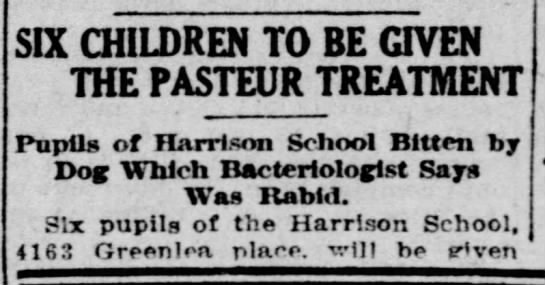
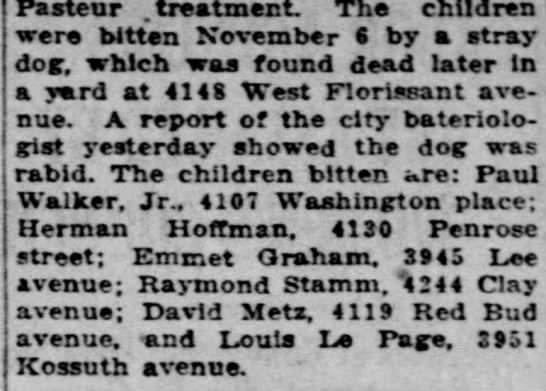
In the news:
A headline in the Nov. 3, 1919, St. Louis Star and Times shows the continued fear of foreigners after WWI. The coal strike and other labor movements were blamed on outside influencers.

A few pages later, the Star shared the reality of the coal miner's life.
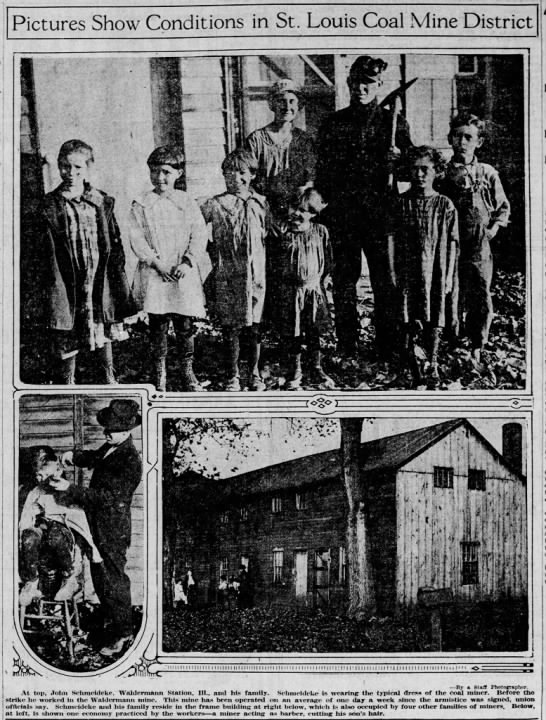
A Nov. 7 photo in the same paper:

Pubic opinion, in general, was against labor organizing.
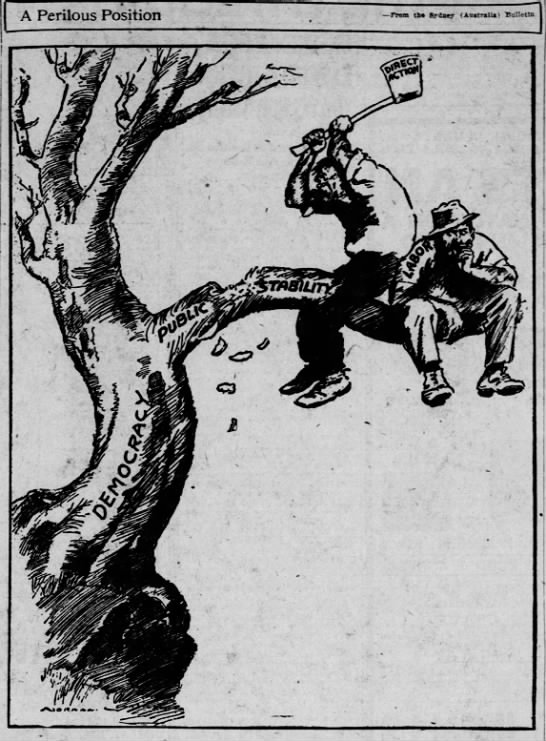
Another instance of how some things don't change, women's dress was blamed for unwanted male attention.

On the other hand, a doctor accused American women of flirting too much but also said that having suitors made women happier and prettier!
" A lack of love affairs would be to my mind more apt to cause that 'tired look' than too great a number. "It is absolutely true that the girl with many suitors looks happier and healthier than the neglected unattractive young woman," continued Dr. Hinkle. "Attention satisfying the ego, makes her feel her own value. Her opportunity to pick and choose from many men gives her a feeling of power. The unsought girl suffers an agony of unappreciation that reflects itself in her unhappy look."
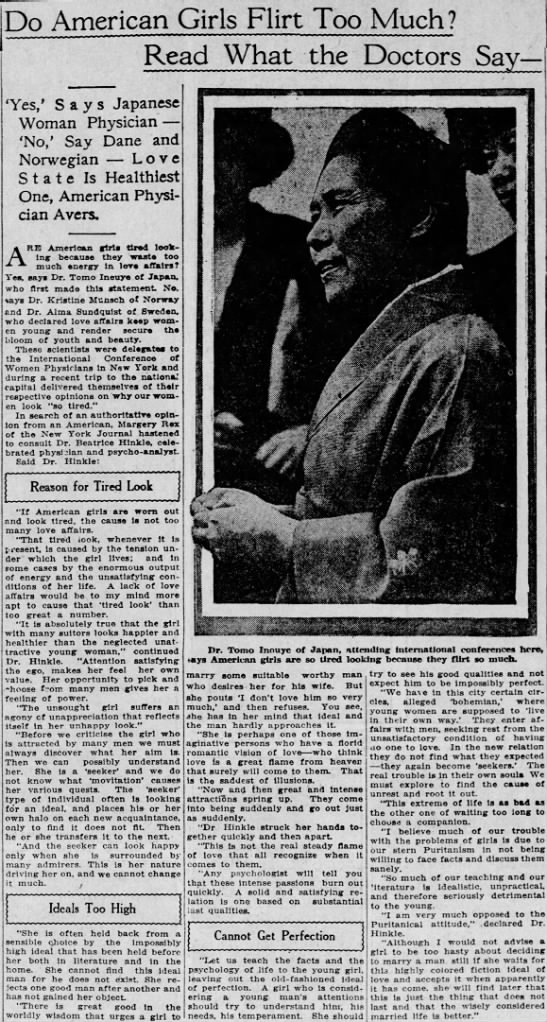
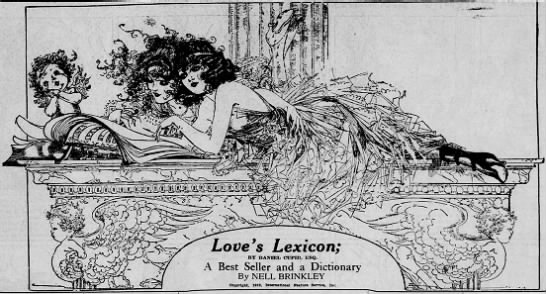 |
| Nov 7, 1919, St Louis Star and Times |
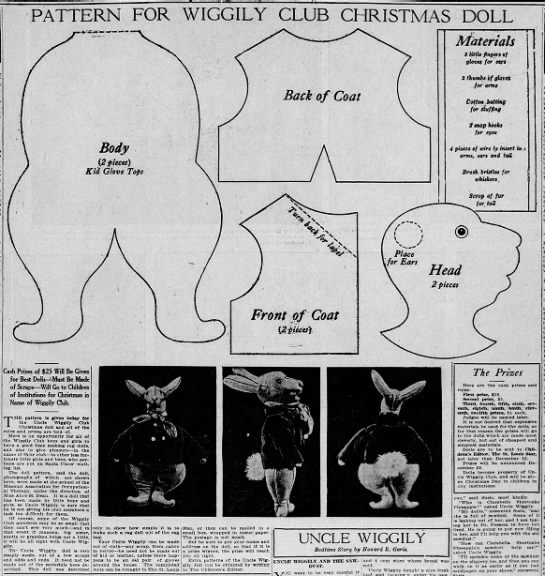
Thursday, November 7, 2019
The Winter Army by Maurice Isserman: The WWII Odyssey of the 10th Mountain Division
Over twenty years ago I met Floyd Erickson, born in the Upper Penninsula Michigan. During WWII Floyd served in the 10th Mountain Division. His life-altering experience under fire on Mt. Belvedere was legendary; everyone knew of his bargain with God which led to his becoming a well-beloved patriarch of the church.
I recall how Floyd, still trim, proudly donned his uniform to join his fellow soldiers at a reunion. And the stories his wife Elizabeth told of how Floyd supported his large U.P. family and the alteration in his character when he returned from war.
Maurice Isserman quotes Floyd in his history of the 10th Mountain Division, The Winter Army, in the chapter concerning the Allied invasion of Kiska. After months of training in extreme conditions, the Army was uncertain of what to do with this 'winter army' of men trained for mountain snow and ice. Their first deployment was to oust the Japanese from Kiska in the Aleutian archipelago.
"It was a terrible night, that first one," Floyd said, recalling the twelve-hour ascent carrying his gear and machine gun ammunition, then digging a foxhole in the pouring rain. The Americans did not know that the Japanese army had already abandoned Kiska. Nineteen mountain troopers died from 'friendly fire'. It was a demoralizing blow.
Isserman narrates the history of this legendary division with details drawn from oral histories that bring the story to life.
Toward the end of the war, the 10th Mountain was sent to the Italian Alps. They were there to keep the German army busy. Climbing the iced mountains, crossing the open Po Valley the Po River, and the final battle was horrific.
Floyd saw his best friend killed in action and suffered permanent hearing loss from a blast.
Isserman's book focuses on the extraordinary men, the "mix of Ivy League students, park rangers, Olympic skiers, and European refugees," who "formed the first specialized alpine fighting force in US history."
After the war, these men impacted the ski industry. One became the first executive director of the Sierra Club; another co-found The Village Voice. One co-founded Nike; another became a renowned historian. And there was Bob Dole, US senator, and presidential candidate.
And there were men like Floyd, an ardent skier from a small town with a large impoverished family, a good man whose life was dedicated to his family and church and community.
I was given access to a free book by the publisher through NetGalley. My review is fair and unbiased.
The Winter Army: The World War II Odyssey of the 10th Mountain Division, America's Elite Alpine Warriors
by Maurice Isserman
Houghton Mifflin Harcourt
Pub Date 05 Nov 2019
ISBN:9781328871435
hardcover $28.00 (USD)
I recall how Floyd, still trim, proudly donned his uniform to join his fellow soldiers at a reunion. And the stories his wife Elizabeth told of how Floyd supported his large U.P. family and the alteration in his character when he returned from war.
Maurice Isserman quotes Floyd in his history of the 10th Mountain Division, The Winter Army, in the chapter concerning the Allied invasion of Kiska. After months of training in extreme conditions, the Army was uncertain of what to do with this 'winter army' of men trained for mountain snow and ice. Their first deployment was to oust the Japanese from Kiska in the Aleutian archipelago.
"It was a terrible night, that first one," Floyd said, recalling the twelve-hour ascent carrying his gear and machine gun ammunition, then digging a foxhole in the pouring rain. The Americans did not know that the Japanese army had already abandoned Kiska. Nineteen mountain troopers died from 'friendly fire'. It was a demoralizing blow.
 |
Floyd Erickson in Italy |
Isserman narrates the history of this legendary division with details drawn from oral histories that bring the story to life.
Toward the end of the war, the 10th Mountain was sent to the Italian Alps. They were there to keep the German army busy. Climbing the iced mountains, crossing the open Po Valley the Po River, and the final battle was horrific.
Floyd saw his best friend killed in action and suffered permanent hearing loss from a blast.
Isserman's book focuses on the extraordinary men, the "mix of Ivy League students, park rangers, Olympic skiers, and European refugees," who "formed the first specialized alpine fighting force in US history."
After the war, these men impacted the ski industry. One became the first executive director of the Sierra Club; another co-found The Village Voice. One co-founded Nike; another became a renowned historian. And there was Bob Dole, US senator, and presidential candidate.
And there were men like Floyd, an ardent skier from a small town with a large impoverished family, a good man whose life was dedicated to his family and church and community.
I was given access to a free book by the publisher through NetGalley. My review is fair and unbiased.
The Winter Army: The World War II Odyssey of the 10th Mountain Division, America's Elite Alpine Warriors
by Maurice Isserman
Houghton Mifflin Harcourt
Pub Date 05 Nov 2019
ISBN:9781328871435
hardcover $28.00 (USD)
Subscribe to:
Posts (Atom)



















